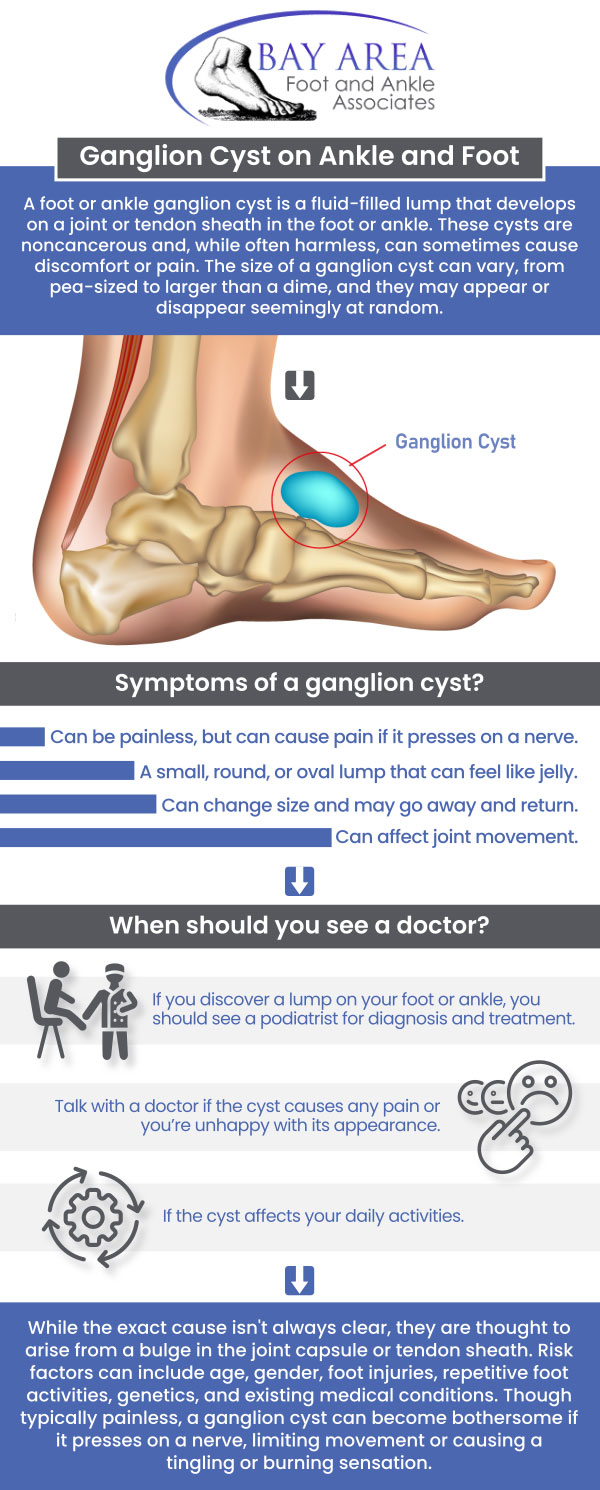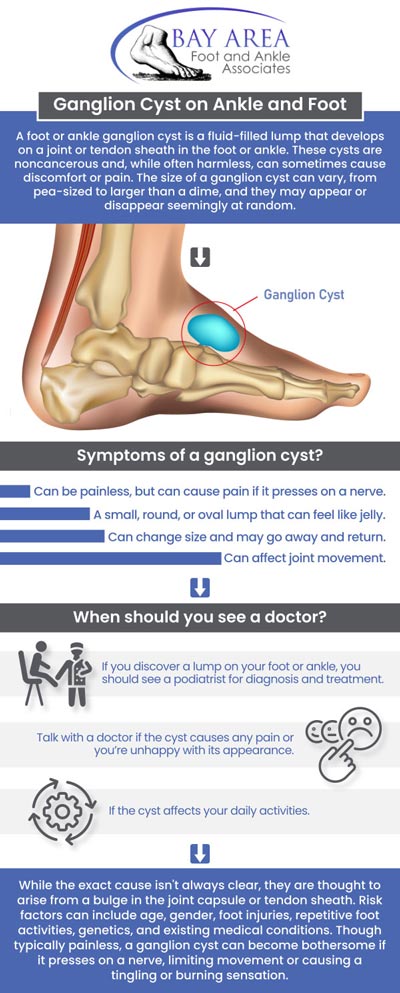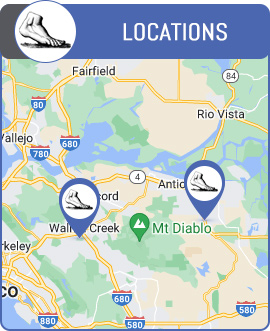Ankle Ganglion Cyst Treatment Specialist Q&A
An ankle ganglion cyst may cause a visible lump, pain, swelling, tenderness, limited mobility, or a feeling of pressure in the affected area. Consult Dr. John W. Scivally, DPM, and Dr. Robin K. Lie, DPM to find the best treatment for long-term relief and mobility. Some ganglion cysts disappear on their own while others linger causing pain and discomfort. Ankle ganglion cyst treatment is available at Bay Area Foot and Ankle Associates. For more information, contact us or schedule an appointment online. We have convenient locations to serve you in Walnut Creek CA and Brentwood CA.




Table of Contents:
How do you get rid of a ganglion cyst on your ankle?
What causes a ganglion cyst on the ankle?
Will the ganglion cyst on my ankle go away?
What does a ganglion cyst on the ankle look like?
Often, ganglion cysts do not cause pain and don’t require treatment. There is a possibility that your doctor will suggest a wait-and-see approach. Our doctor may recommend a variety of options if the cyst causes pain or hinders joint movement
To prevent the ganglion cyst from growing larger, a brace or splint may provide temporary immobilization. It is possible that your nerves will be relieved of pain as the cyst shrinks, allowing it to release pressure on them. Braces and splints should not be used long-term, as they can weaken the muscles around them.
Cysts are drained using an aspiration procedure, during which a needle is used to draw fluid out of them. It is possible for the cyst to recur.
In the event that other approaches haven’t proven effective, surgery may be a viable option. The doctor removes the cyst and the stalk that attaches it to the joint or tendon during this procedure. In rare instances, nerves, blood vessels, or tendons can be injured during surgery. It is possible for the cyst to recur, even after surgery.
A ganglion cyst is a round, liquid-filled growth that develops along a joint or tendon. Additionally, they can grow up to an inch in diameter, causing pain and pressure on surrounding nerves. Recurrence of Ganglion cysts is also possible in rare cases.
It is unknown what causes ganglion cysts. Trauma or repeated irrigation can cause the surrounding tissue to become displaced and result in their formation. On the top of the foot or ankle, this displacement of tissue causes a round lump to form. The formation of ganglion cysts may also occur in those who suffer from arthritis and bone spurs. Several theories suggest that joint cysts are caused by trauma or a flaw in the capsule or sheath of the joint.
There are several benign soft-tissue masses that can appear in the body, such as ganglion cysts. These conditions often develop on the wrist, but they can also occur on the foot, usually on the top, but also elsewhere. The size of ganglion cysts may vary, get smaller and larger, or disappear entirely, only to return in the future.
If the cyst doesn’t disappear on its own you may visit a doctor for diagnosis and treatment. Your doctor may apply pressure to the cyst to determine whether it is tender or uncomfortable during the physical exam. In order to determine whether the cyst is filled with fluid or a solid mass, the doctor may shine a light through it. To rule out other conditions, such as arthritis or a tumor, your doctor may recommend imaging tests such as X-rays, ultrasounds, or magnetic resonance imaging (MRI). A magnetic resonance imaging (MRI) or ultrasound can also locate cysts that are hidden (occult). Aspiration, which involves drawing out the cyst’s fluid with a needle and syringe, may confirm the diagnosis of ganglion cysts. Once the nature of the cyst has been determined, treatment will be administered as needed.
Cysts called ganglion cysts develop on the outside of joints, tendons, or other parts of the body, such as the hands or knees. Ganglion cysts are fluid-filled, benign tumors. Under the skin, these cysts appear as small sacs filled with a clear, jellylike substance, which may feel firm to the touch or spongy to the touch. The ankle, toe, wrist, finger, knee, and other joints can develop ganglion cysts, which are small (1-3 cm) raised bumps. Upon shining light through these small, noncancerous tumors, a thick, clear, sticky material can be seen.
A ganglion cyst may appear suddenly or develop over time. Symptoms often include visible lumps as well as pain when using the affected joint and an increase in cyst size during activity and a decrease during rest. There are, however, some ganglion cysts that cause no pain at all.
Ankle ganglion cyst treatment is available at Bay Area Foot and Ankle Associates. For more information, contact us or schedule an appointment online. We have convenient locations to serve you. We serve patients from Walnut Creek CA, Brentwood CA, Concord CA, Pleasant Hill CA, Pittsburg CA, Antioch CA, Alamo CA, Danville CA, Oakley CA, and surrounding areas.

Additional Services You May Need
▸Custom Foot Orthotics
▸Ingrown Toenail Specialist
▸Traditional Podiatry Care
▸Foot and Ankle Surgery Clinic
▸Bunion Doctor
▸Corns and Calluses
▸Foot Arthritis and Joint
▸Warts
▸Video Gait Analysis
▸Athletic Taping
▸Pediatric Foot Specialist
▸Gait Abnormalities
▸Foot Dermatologist
▸Foot Deformities
▸Chronic Foot Injury
▸Diabetic Foot Specialist
▸Acute Foot Injuries
▸Podiatric Sports Services
▸Plantar Fasciitis Specialists


